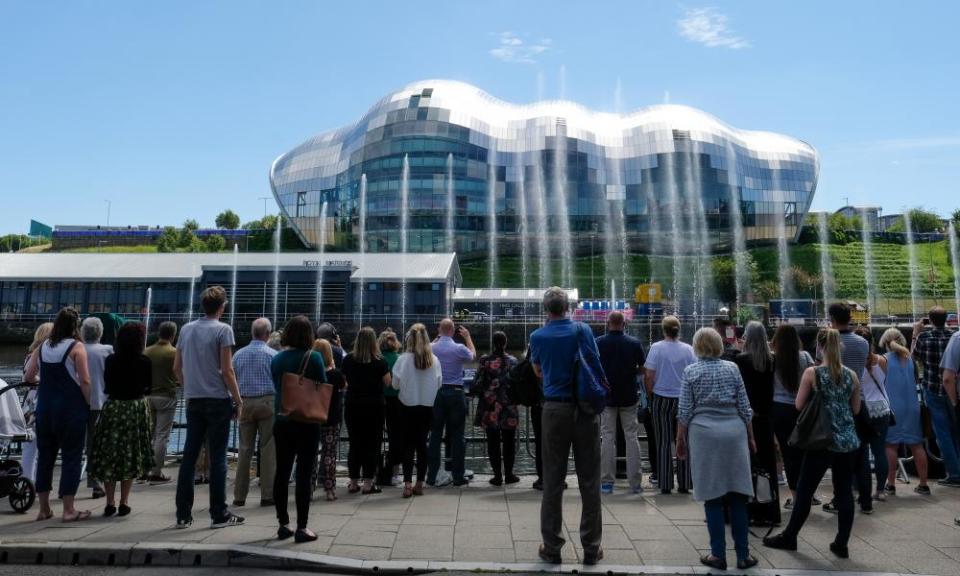Newcastle's Great Exhibition aims to create buzz on a budget

A mural featuring a Greggs steak bake and the UK’s largest water sculpture are among the attractions at the Great Exhibition of the North, a summer-long festival which aims to emulate the success of the Victorians’ world expositions on a tiny fraction of the budget.
The exhibition, which opened on Friday with a blast of confetti on the Quayside in Newcastle, has been set up to shine a light on the north of England’s cultural and industrial past and present. It was the brainchild of the former chancellor George Osborne, who championed the idea of a “northern powerhouse”.
Two years ago, when Osborne was still in post, the government held a competition among northern English cities to host the event. Newcastle/Gateshead won £5m towards the exhibition itself, with a further £15m put into a legacy fund to attract further cultural investment in the region.
One of the highlights of the 80-day event is a family-friendly exhibition featuring more than 200 items on loan from the UK’s leading museums, galleries and private collections. Star exhibits include a spacesuit worn by the Sheffield-born astronaut Helen Sharman; a rare miniature book created by Charlotte Brontë; and the last piano played by John Lennon. The show, at the Great North Museum in Newcastle, includes a special event where children can learn how Postman Pat is animated.
Each night the 80-metre-long water sculpture in the Tyne will be illuminated. The water will shoot up the height of the Tyne Bridge, dancing to a soundtrack of specially commissioned collaborations by Maximo Park and Kate Rusby with Royal Northern Sinfonia and Darkstar.
Stephenson’s Rocket, an early steam locomotive made in Newcastle in 1829 at a works on Forth Banks, will be on display at the Discovery Museum, alongside a modern Azuma train, made in Newton Aycliffe in County Durham. The Rocket has been held at London’s Science Museum since 1862, but Newcastle council is agitating to have it returned permanently.
“Stephenson’s Rocket is our Elgin marbles. It should be here all the time,” said Nick Forbes, the leader of Newcastle city council, at the exhibition launch at the Sage in Gateshead on Friday. Michael Ellis, the tourism minister, attended but refused to get involved. “The government does not interfere with curatorial decisions,” he said, adding that it made sense for such national treasures to be seen “by the greatest number of people possible”.
Prof John Tomaney, who works at the Bartlett School of Planning at University College London but lives in Gateshead, suggested the £5m given by the government to the hosts was “small beer”.
“Five million pounds would not buy Newcastle United FC a run-of-the-mill attacking midfielder, but would, almost, buy a sensitively refurbished grade 2-listed house in Notting Hill,” he wrote recently, adding: “GEN is the latest in a line of projects that are nationally conceived and overseen, hindered by limited resources, burdened by overblown claims about likely impacts and with questionable objectives.”
The Royal Opera House, based in London, receives more than £24.7m of government funding each year via the Arts Council. Opera North in Leeds gets £10.3m. The Baltic gallery in Gateshead – which during the exhibition is hosting a show by the Preston-based artist Lubaina Himid, who won the Turner prize last year – receives £3.1m from the Arts Council annually.

The artist Frank Styles, who was putting the finishing touches to his mural outside the Northern Design Centre, said: “The money the government has given the Great Exhibition is a drop in the ocean compared with the cuts local councils here have had to make as a result of Tory austerity. Where I live, in Sunderland, all the satellite libraries have closed and the Northern Gallery for Contemporary Art has been downgraded and forced to share premises with the National Glass Centre.” He added: “It’s art-washing.”
He urged visitors to look up a fringe project, calling itself The Other Great Exhibition of the North, which was holding a protest march from Haymarket in Newcastle at 5pm on Friday.
His mural incorporates 50 northern icons voted for by members of the public, including a Greggs steak bake, the Angel of the North and a Yorkshire pudding.
Martin Gannon, the leader of Gateshead council, said he welcomed the government investment, but would continue to fight for a fair deal for the £143m stripped out of his budget since 2010, with another £32m expected to go in the next three years. “Having said that, I can bemoan that, and I will, but ultimately we’ve got to make more money and build our economy,” he said, optimistic that hosting the exhibition would bring millions to the area.
Organisers anticipate that 3 million people will visit the exhibition and collectively spend £184m locally. The original Great Exhibition, held in Hyde Park in London between May and October of 1851, attracted 6 million paying visitors, equivalent to a third of the population of Britain at the time.

 Yahoo News
Yahoo News 